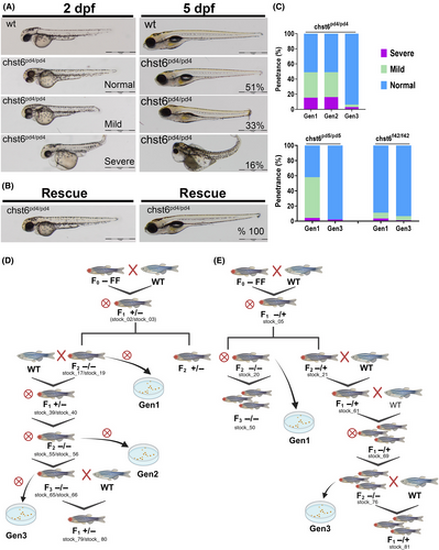
Low penetrance morphological defects were observed in the mutant embryos. (A, B) Morphology of the wt, mutant, and mRNA-injected mutant embryos was analyzed at 2 and 5 dpf. Scale bars: 1 mm. (A) While majority of embryos displayed normal morphology, 33% had mild bending at the anterior end of the tail, 16% had severe defects including bending of the anterior trunk, hearth, and yolk edema at 2 dpf (left), and these phenotypes became more severe at 5 dpf (right) and they were nearly lethal with prominent edema in heart and yok, underdeveloped head, and grossly curved trunk (n = 113). (B) The morphological defects were fully rescued when wt chst6 mRNA was injected to 1-cell stage embryo, with 100% of the mutants has normal morphology at 2 and 5 dpf (n = 68). (C) Penetrance of morphological defect phenotype was analyzed at different generation in all three alleles, and ratios are shown in graphs. The defects were observed in < 5% of the mutants in generation (gen)2 and gen3 (n = 54, 84 and 226 for gen1, gen2, and gen3 of chst6pd4/pd4; n = 119 and 44 for gen1 and gen3 of chstpd5/pd5; n = 290 and 84 for gen1 and gen3 of chst6f42/f42, respectively). The breeding schemes for zebrafish mutant lines are illustrated in (D) for chst6pd4/pd4 and chst6pd5/pd5, (E) for chst6f42/f42 mutant lines. Generations depicted in graphs (in C) are defined in the crossing schemes. Circled cross indicates inbreeding. D and E were created with BioRender.com
|

